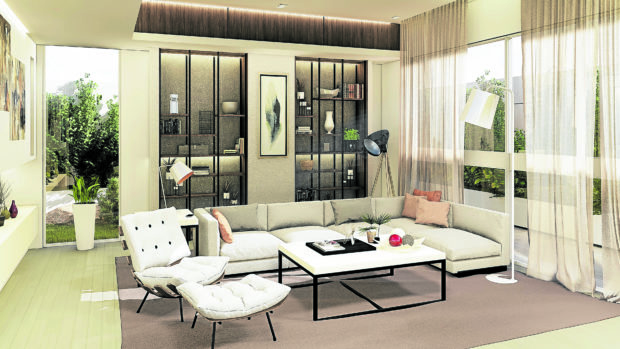Passive ventilation tricks for your living spaces
The good news is, a gust of wind is free. The bad news is, most of them are outside your home. Bringing those light breezes into your residences could be challenging for some. And it gets even more interesting when we consider in the equation the effects of tropical rains.
A tropical climate isn’t only about the sun
When people hear the word “tropical,” the common imagery paints sunny beaches with brightly lit landscapes of palm trees and thatched roofed houses. However, let us not forget that what comprises the other half of the tropical climate is the rainy season.
And when you live in a tropical country like the Philippines, understanding how rainwater behaves is an integral part of tropical design. Otherwise, a well-intended passive ventilation design approach with large window openings and a wind-oriented layout could lead to unwanted rainwater intrusions into your home. In a situation that eliminates one in favor of the other, how do we incorporate passive ventilation techniques that will remain agreeable even during the rainy days of the year? There are ways to keep your house cool but dry all year round.
Be the conductor of your house’s airflow
Having some control of how wind direction flows into your home and guiding them throughout the property will allow certain opportunities when it comes to arranging interior spaces.
For example, assigning various window area sizes to trick airflow from smaller openings to navigate towards larger openings is called a “squeeze point.” This “squeeze point” works as a natural vacuum that increases wind velocity thereby increasing evaporation and cooling people faster.
Article continues after this advertisementAnother aspect of passive ventilation design is about orienting the building structure or overall shape towards prevailing winds. As such, make sure to locate your house’s openings at oblique angles, so that the prevailing winds will also slide at the same angle of around 45 to 50 degrees. Airflow at oblique angles results in more active indoor air movements being distributed throughout the house.
Article continues after this advertisementThe next thing to tackle is elevation. The principle of the “stack effect” is done by creating openings at both high and low portions to encourage some indoor ventilation upwards. Hot indoor air will float towards the top opening while leaving a vacant space for cooler outdoor air to come in.
Sometimes, it’s better not to hit two birds with one stone
We’ve always heard passive ventilation being paired with natural lighting most of the time. However, there are cases when a house’s natural ventilation gets unknowingly compromised in attempts to achieve both qualities with the same openings.
Sunlight invites natural heat gain. Try to pinpoint locations that produce the most natural glow with minimal heat retention. At night, better to shift to LED light systems that produce less heat and are more energy-efficient than the standard incandescent light bulb.
Contrary to popular belief, curtains and blinds aren’t only used for shade. Opening accessories also play a huge role in keeping your home well-ventilated. Darker curtains exposed to sunlight can capture higher temperatures since they absorb heat. It would be wise to avoid them if you can. If not, at the least is to try to diffuse the situation with lighter-colored curtains facing the sun.
Timing is important, especially at night
A less popular yet just as effective option is called night cooling or night flushing, which works by flushing warm air out and allowing the cold night air to have direct contact with individual elements of the thermal mass such as walls and floor slabs. This results in a lower room temperature for the next day.
Sliding doors that lead to an open outdoor space increase the effectiveness of night cooling or night flushing. These doors are best lined with grilles and insect screens for optimum pest protection.
Countries that have a tropical climate often have large temperature differences between day and night. This is the reason why having options for porosity is much more advisable than being fully enclosed. We can increase the comfort levels by simply adding another fixture found in almost all Filipino homes—the electric fan. An electric fan operating near an open door or window guides airflow into the inner portion of the room. Having another opening at the end of the room will induce cross-ventilation. Other options include installing the ever-reliable ceiling fans or an exhaust fan at a window transom nearest to a stairway’s top landing.
Back to nature
Trees serve as natural buffer zones that generate shade and cooler air. They are also essential for blocking wind-driven rains from entering your house. It would be wise to occasionally manage their growth so as not to interfere with power and telecommunication lines, block those wonderful landscape views, or have dead leaves and branches clogging the gutters.The trick behind a tricky climate
Since ventilation is a forced process, even though the supply of fresh air is unlimited, the system does not provide a constant supply. If ventilation were perfect, then there would be continuous airflow throughout the building. The combined effects of high humidity, strong winds and rain can create a very unfriendly environment for people to live in. Luckily, careful planning and design strategies combined with the right accessories can keep your home well-ventilated and dry all year round.The author is the principal architect of Fulgar Architects helping local and international property developers get into unique and diversified planning and design specialties for real estate, hospitality, condominiums, commercial and mixed-use township developments. Visit Fulgararchitects.com
